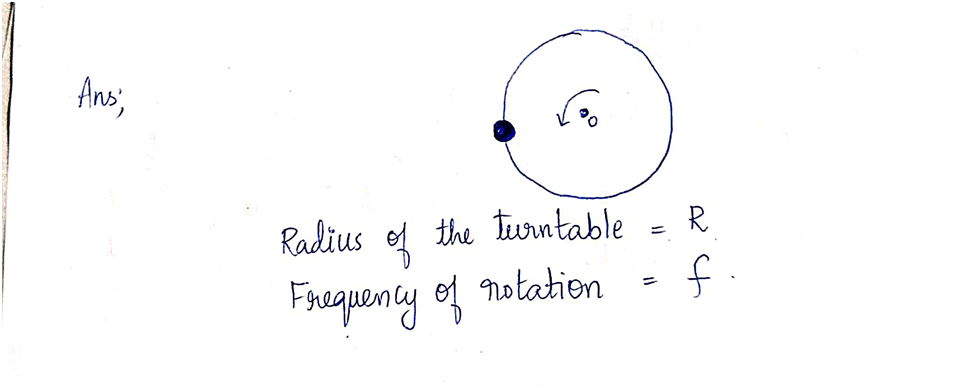A coin is placed near the edge of a turntable of radius R rotating with constant frequency f. The figure shows a top view of the arrangement. a) What is the relation between the radius of the turntable, the frequency of revolution, and the speed of the coin? Remember f 1/T. b) Add an arrow to the figure indicating the direction of acceleration of the coin when it rotates with the turntable c) Draw a free-body diagram for the coin in side view. Please remember to include a coordinate system and to label your forces. d) If the turntable rotates slowly, the coin will move with the turntable. However, if it rotates too fast, the coin will slide off. Assuming that the static friction coefficient between the coin and the turntable is us, derive an equation for the maximum frequency at which the turntable can spin before the coin slides off. e) If the maximum speed is exceeded, the coin slides off. For this case, add the coin's trajectory (top view) to the sketch on the right.
A coin is placed near the edge of a turntable of radius R rotating with constant frequency f. The figure shows a top view of the arrangement. a) What is the relation between the radius of the turntable, the frequency of revolution, and the speed of the coin? Remember f 1/T. b) Add an arrow to the figure indicating the direction of acceleration of the coin when it rotates with the turntable c) Draw a free-body diagram for the coin in side view. Please remember to include a coordinate system and to label your forces. d) If the turntable rotates slowly, the coin will move with the turntable. However, if it rotates too fast, the coin will slide off. Assuming that the static friction coefficient between the coin and the turntable is us, derive an equation for the maximum frequency at which the turntable can spin before the coin slides off. e) If the maximum speed is exceeded, the coin slides off. For this case, add the coin's trajectory (top view) to the sketch on the right.
College Physics
11th Edition
ISBN:9781305952300
Author:Raymond A. Serway, Chris Vuille
Publisher:Raymond A. Serway, Chris Vuille
Chapter1: Units, Trigonometry. And Vectors
Section: Chapter Questions
Problem 1CQ: Estimate the order of magnitude of the length, in meters, of each of the following; (a) a mouse, (b)...
Related questions
Question
100%
Part C,D, and E

Transcribed Image Text:A coin is placed near the edge of a turntable of radius R rotating with
constant frequency f. The figure shows a top view of the arrangement.
a) What is the relation between the radius of the turntable, the
frequency of revolution, and the speed of the coin?
Remember f 1/T.
b) Add an arrow to the figure indicating the
direction of acceleration of the coin when it
rotates with the turntable
c) Draw a free-body diagram for the coin in
side view. Please remember to include a
coordinate system and to label your forces.
d) If the turntable rotates slowly, the coin will move with the turntable. However, if it rotates too
fast, the coin will slide off. Assuming that the static friction coefficient between the coin and the
turntable is us, derive an equation for the maximum frequency at which the turntable can spin before
the coin slides off.
e) If the maximum speed is exceeded, the coin slides off. For this case,
add the coin's trajectory (top view) to the sketch on the right.
Expert Solution
Step 1
The student has asked to answer the sub-parts C, D, E.

Trending now
This is a popular solution!
Step by step
Solved in 3 steps with 3 images

Knowledge Booster
Learn more about
Need a deep-dive on the concept behind this application? Look no further. Learn more about this topic, physics and related others by exploring similar questions and additional content below.Recommended textbooks for you

College Physics
Physics
ISBN:
9781305952300
Author:
Raymond A. Serway, Chris Vuille
Publisher:
Cengage Learning

University Physics (14th Edition)
Physics
ISBN:
9780133969290
Author:
Hugh D. Young, Roger A. Freedman
Publisher:
PEARSON

Introduction To Quantum Mechanics
Physics
ISBN:
9781107189638
Author:
Griffiths, David J., Schroeter, Darrell F.
Publisher:
Cambridge University Press

College Physics
Physics
ISBN:
9781305952300
Author:
Raymond A. Serway, Chris Vuille
Publisher:
Cengage Learning

University Physics (14th Edition)
Physics
ISBN:
9780133969290
Author:
Hugh D. Young, Roger A. Freedman
Publisher:
PEARSON

Introduction To Quantum Mechanics
Physics
ISBN:
9781107189638
Author:
Griffiths, David J., Schroeter, Darrell F.
Publisher:
Cambridge University Press

Physics for Scientists and Engineers
Physics
ISBN:
9781337553278
Author:
Raymond A. Serway, John W. Jewett
Publisher:
Cengage Learning

Lecture- Tutorials for Introductory Astronomy
Physics
ISBN:
9780321820464
Author:
Edward E. Prather, Tim P. Slater, Jeff P. Adams, Gina Brissenden
Publisher:
Addison-Wesley

College Physics: A Strategic Approach (4th Editio…
Physics
ISBN:
9780134609034
Author:
Randall D. Knight (Professor Emeritus), Brian Jones, Stuart Field
Publisher:
PEARSON